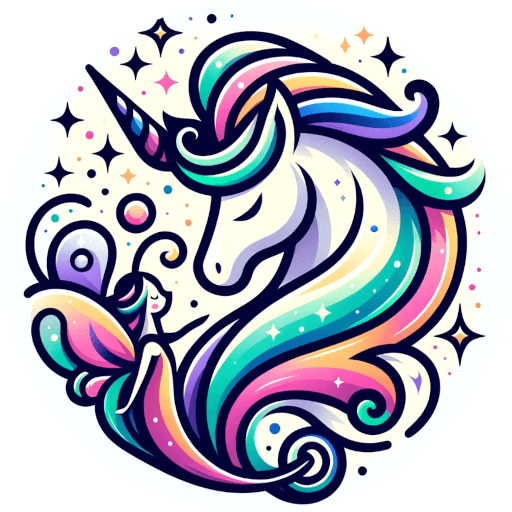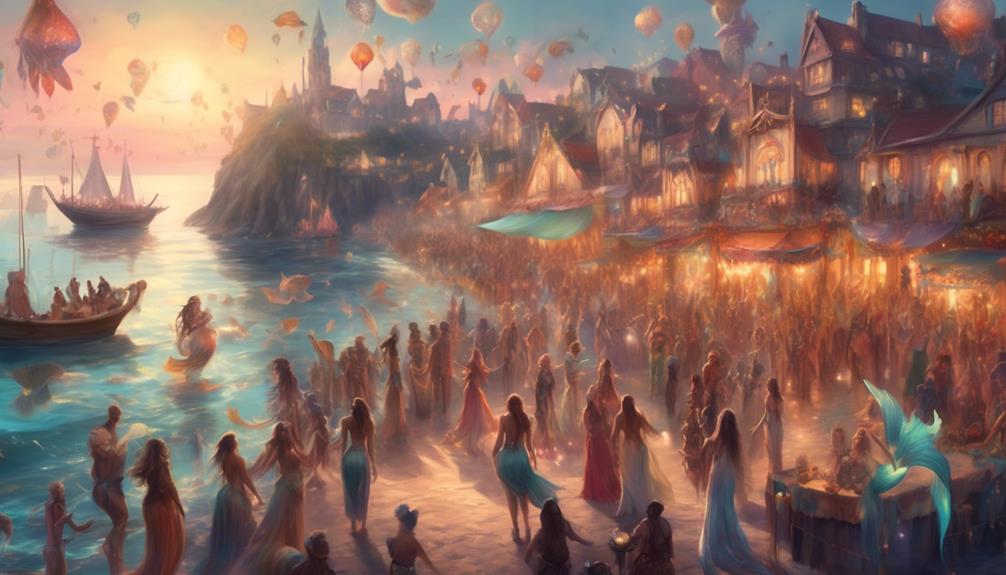What if mythical creatures could transcend the confines of folklore and inspire cultural shifts?
The enigmatic combination of a mermaid and a centaur, with its unique fusion of aquatic and terrestrial elements, has captivated the imagination of artists, storytellers, and scholars across centuries.
From ancient myths to contemporary pop culture, the mermaid-centaur hybrid has left an indelible mark on human creativity and societal beliefs.
Exploring the cultural impact of this intriguing creature offers a compelling insight into the evolution of human thought and expression.
Key Takeaways
- Mermaid-centaur hybrids have deep historical and mythological roots in various ancient cultures, including Mesopotamian, Greek, and Roman societies.
- These hybrids symbolize the harmonious coexistence of land and sea, acting as guardians of sacred spaces and mediators between earthly and divine realms.
- Artistic representations of mermaid-centaur hybrids have evolved over time, adapting to prevailing cultural and social contexts, and inspiring various forms of artistic expression.
- The fusion of mermaid and centaur embodies the human fascination with the unknown and the struggle to reconcile opposing forces, reflecting ongoing conversations about diversity, inclusion, and the challenge of traditional gender roles and stereotypes.
Historical Depictions of Mermaid-Centaur Hybrids
Historical depictions of mermaid-centaur hybrids have been found in various ancient cultures, often symbolizing the blending of land and sea, and the duality of human and animal characteristics. These intriguing creatures have ancient origins, with evidence of their existence dating back to early civilizations such as the Mesopotamian, Greek, and Roman societies.
In Mesopotamian mythology, the deity Enki is represented as a merman, emphasizing the connection to water and wisdom. Meanwhile, in Greek mythology, the centaur is a symbol of untamed nature and the conflict between civilization and wilderness. By combining these two mythical beings, the mermaid-centaur hybrid represents a fusion of these contrasting elements, suggesting a complex interplay between the human and natural worlds.
The cultural significance of these depictions is multifaceted. They often serve as allegorical representations of the human psyche, reflecting the internal struggles and desires faced by individuals within their respective societies. Additionally, the prevalence of these hybrids in diverse cultures underscores their universal appeal and the enduring fascination with the intersection of humanity and the natural world.
Through these ancient depictions, the mermaid-centaur hybrid continues to captivate and inspire, transcending time and cultural boundaries.
Symbolism and Folklore Surrounding Mermaid-Centaur Hybrids
The rich symbolism and folklore surrounding mermaid-centaur hybrids extends beyond their historical depictions, offering a profound insight into the cultural narratives and spiritual beliefs of various ancient civilizations. These mythical beings often carry symbolic meanings deeply rooted in the cultural significance of the societies that created them.
In various folklore, mermaid-centaur hybrids are depicted as guardians of sacred spaces, embodying the duality of human and animalistic traits, and serving as mediators between the earthly and divine realms.
In some cultures, mermaid-centaur hybrids symbolize the harmonious coexistence of land and sea, reflecting the interconnectedness of ecosystems and the delicate balance between nature and humanity. Additionally, their portrayal in folklore often mirrors the societal values and norms of the time, representing themes of fertility, transformation, and the mysteries of the unknown.
Comparative studies of these myths across different civilizations reveal the universal themes of love, freedom, and the perpetual human quest for understanding the enigmatic forces of the natural world. The symbolic meanings attributed to mermaid-centaur hybrids illustrate the enduring cultural significance of these mythical creatures and their ability to convey timeless truths about the human experience.
Artistic Representations of Mermaid-Centaur Hybrids
Artistically, mermaid-centaur hybrids have been depicted in a myriad of ways across various cultures and time periods, reflecting the evolving artistic interpretations of these mythical beings.
Creative interpretations of mermaid-centaur hybrids can be found in ancient Greek pottery, where they were often portrayed as symbols of freedom and untamed nature. In contrast, Renaissance art frequently depicted them as allegories of morality and the struggle between earthly desires and spiritual aspirations. These diverse representations highlight the flexibility of mermaid-centaur hybrids as artistic symbols, adapting to the prevailing cultural and social contexts.
Furthermore, in contemporary art, mermaid-centaur hybrids continue to inspire creative interpretations, often serving as a metaphor for the complexities of identity and the blending of disparate elements. Whether portrayed in paintings, sculptures, or digital art, these hybrids provide artists with a rich and versatile symbol to explore themes of duality, transformation, and the interconnectedness of seemingly opposing forces.
Through their artistic symbolism, mermaid-centaur hybrids persist as compelling figures that transcend time and culture, inviting ongoing exploration and reinterpretation.
Mythological Influence of Mermaid-Centaur Hybrids
As artists have continued to explore the symbolic potential of mermaid-centaur hybrids, their mythological influence has endured as a captivating subject of in-depth analysis and contextual interpretation. These mythical creatures hold significant cultural significance, drawing from the rich traditions of both mermaids and centaurs.
The mermaid, known for her enchanting beauty and association with the sea, symbolizes themes of femininity, allure, and the unknown depths of the ocean. On the other hand, the centaur embodies the duality of human intellect and animalistic instincts, often representing wisdom, strength, and untamed nature. The fusion of these two iconic beings creates a complex symbol that intertwines the allure of the sea with the untamed spirit of the wilderness.
In a comparative study of mermaid-centaur hybrids with other mythological creatures, it becomes evident that their cultural impact stems from the juxtaposition of contrasting elements. The hybrid's portrayal often reflects the human fascination with the unknown and the struggle to reconcile opposing forces. This exploration of duality and unity resonates deeply within the human psyche, making mermaid-centaur hybrids a compelling subject for mythological analysis.
Contemporary Pop Culture Portrayals of Mermaid-Centaur Hybrids
Renowned for their enigmatic presence in contemporary pop culture, mermaid-centaur hybrids continue to captivate audiences with their symbolic complexity and enduring allure.
In today's media landscape, these fantasy creatures are represented in various forms, from literature to visual arts and even in digital and interactive media. Their portrayal often reflects the evolving societal values and serves as a mirror to contemporary issues.
Contemporary pop culture representations of mermaid-centaur hybrids often depict them as symbols of duality, representing the harmony or conflict between different entities, such as land and sea, human and animal, or even conflicting emotions and desires. These representations offer a rich tapestry of symbolism and metaphor, inviting audiences to explore the complexities of the human experience.
Furthermore, in contemporary pop culture, mermaid-centaur hybrids are often used to challenge traditional gender roles and stereotypes, showcasing them as powerful and independent beings. Their representation serves as a reflection of the ongoing conversations about diversity and inclusion in modern society.
Moreover, their portrayal in pop culture media often highlights the fusion of different cultural elements, demonstrating the universal appeal of these mythical beings across different societies and traditions.
Frequently Asked Questions
Are There Any Specific Rituals or Ceremonies Associated With Mermaid-Centaur Hybrids in Certain Cultures?
Specific rituals or ceremonies associated with mermaid-centaur hybrids in certain cultures have not been extensively documented. However, their cultural significance and gender identity perceptions have sparked modern sightings, myth exploration, and stereotype analysis in various societies.
What Are Some Lesser-Known Stories or Myths About Mermaid-Centaur Hybrids That Have Not Been Widely Explored in Popular Culture?
Exploring folklore and uncovering legends, researchers have delved into ancient origins of mermaid-centaur hybrids. Folklore exploration has brought to light lesser-known stories and myths, offering a deeper understanding of these intriguing cultural representations.
How Do Different Societies Perceive and Interpret the Gender Identity of Mermaid-Centaur Hybrids?
Different societies perceive and interpret the gender identity of mermaid-centaur hybrids through a lens of traditional beliefs and cultural interpretations. Modern encounters with these mythological creatures often spark discussions on how gender identity is understood and represented.
Are There Any Documented Sightings or Encounters With Mermaid-Centaur Hybrids in Modern Times?
Historical accounts and folklore often mention mermaid-centaur hybrids, but no scientific evidence supports their existence. Cryptid sightings are often attributed to misidentifications. The cultural fascination with these mythical beings continues to inspire artistic and literary works.
What Are Some Common Misconceptions or Stereotypes About Mermaid-Centaur Hybrids That Are Perpetuated in Contemporary Media?
Misconceptions about mermaid-centaur hybrids in modern media perpetuate stereotypes about their gender identity. Representation often focuses on their physical appearance rather than their cultural significance. Modern encounters challenge these portrayals, highlighting diverse perspectives.

